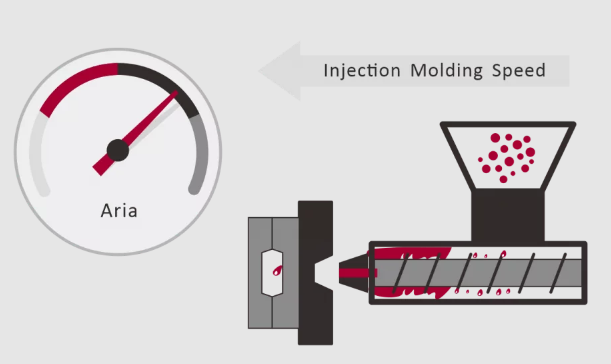
Screw speed in injection molding refers to the rotational speed of the screw within the injection molding machine’s barrel during the plasticizing phase. This speed is typically measured in revolutions per minute (RPM) and plays a crucial role in determining the quality and consistency of the molten plastic that will be injected into the mold. Here’s a detailed explanation of screw speed and its significance in injection molding:
Definition of Screw Speed
Screw Speed: The rate at which the screw rotates inside the barrel during the plasticizing phase, where solid plastic pellets are melted and homogenized into a uniform molten state before being injected into the mold cavity.
[elementor-template id=”4331″]
Importance of Screw Speed
- Melt Quality:
- Proper screw speed ensures thorough melting and mixing of the plastic material, resulting in a homogeneous melt that is free of unmelted particles.
- Temperature Control:
- Screw speed affects the shear heat generated during plasticizing. Appropriate speed settings help maintain the optimal melt temperature, preventing thermal degradation or incomplete melting.
- Cycle Time:
- Optimizing screw speed can reduce cycle times by balancing the plasticizing phase duration with other phases of the injection molding cycle.
- Material Properties:
- Correct screw speed ensures that the mechanical properties of the plastic are preserved, affecting the strength, flexibility, and overall performance of the molded parts.
Factors Influencing Screw Speed
- Material Type:
- Different materials have varying melting points and viscosity characteristics. The screw speed must be adjusted according to the specific material being processed to achieve proper melting and mixing.
- Screw Design:
- The design of the screw, including its diameter, length, and geometry, influences how the material is conveyed, melted, and mixed. The screw speed should complement the screw design to optimize plasticizing efficiency.
- Part Design and Requirements:
- The complexity, size, and precision requirements of the molded part dictate the need for specific melt quality and temperature control, influencing the appropriate screw speed setting.
- Machine Capabilities:
- The capabilities of the injection molding machine, such as its maximum screw speed and torque, also determine the optimal screw speed settings.
Setting and Controlling Screw Speed
- Initial Setup:
- The initial screw speed setting is based on the material manufacturer’s recommendations and the requirements of the specific molding application.
- Monitoring and Adjustment:
- During the molding process, the screw speed should be monitored and adjusted as necessary to ensure consistent melt quality and process stability. This can involve real-time adjustments based on feedback from process monitoring systems.
- Optimization:
- Through trial and error and process optimization techniques, the screw speed can be fine-tuned to achieve the best balance between cycle time, part quality, and material efficiency.
[elementor-template id=”4330″]
Consequences of Incorrect Screw Speed
- Too High Screw Speed:
- Overheating: Excessive shear heat can cause the material to degrade, leading to discoloration, reduced mechanical properties, and increased risk of defects like burn marks.
- Air Entrainment: High speeds can trap air in the melt, leading to voids or bubbles in the final part.
- Too Low Screw Speed:
- Incomplete Melting: Insufficient shear heat can result in unmelted pellets, causing poor surface finish, weak spots, and structural defects in the molded parts.
- Longer Cycle Times: Slower speeds may extend the plasticizing phase, increasing the overall cycle time and reducing production efficiency.
Conclusion
Screw speed in injection molding is a critical parameter that significantly impacts the quality of the molten plastic, the efficiency of the molding process, and the properties of the final product. Properly setting and controlling screw speed, considering factors such as material type, screw design, part requirements, and machine capabilities, is essential for optimizing the injection molding process and ensuring the production of high-quality parts. Regular monitoring and adjustment of screw speed help maintain process stability and minimize defects, contributing to efficient and cost-effective manufacturing.
Related Conten: Expert Large Plastic Molds Manufacturing
 DTG Mould Trade Process |
|
| Quote: | According to sample, drawing and specific requirement. |
|---|---|
| Discussion | Mold material, cavity number, price, runner, payment, etc. |
| S/C Signature | Approval for all the items. |
| Advance | Pay 50% by T/T |
| Product Design Checking | We check the product design. If some position is not perfect, or can not be done on the mould, we will send customer the report. |
| Mold Processing | Send report to customer once each week |
| Mold Testing | Send trial samples and try-out report to customer for confirmation |
| Mold Modification | According to customer’s feedback. |
| Balance Settlement | 50% by T/T after the customer approved the trial sample and mould quality. |
| Delivery | Delivery by sea or air. The forwarder can be designated by your side. |
 |
|

